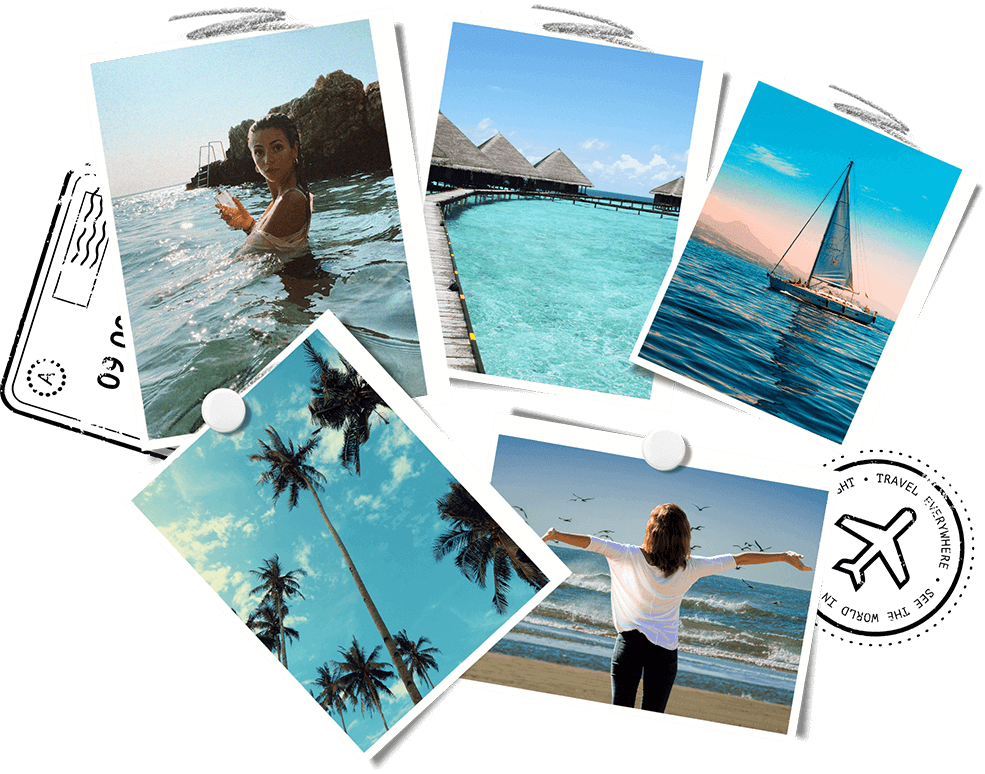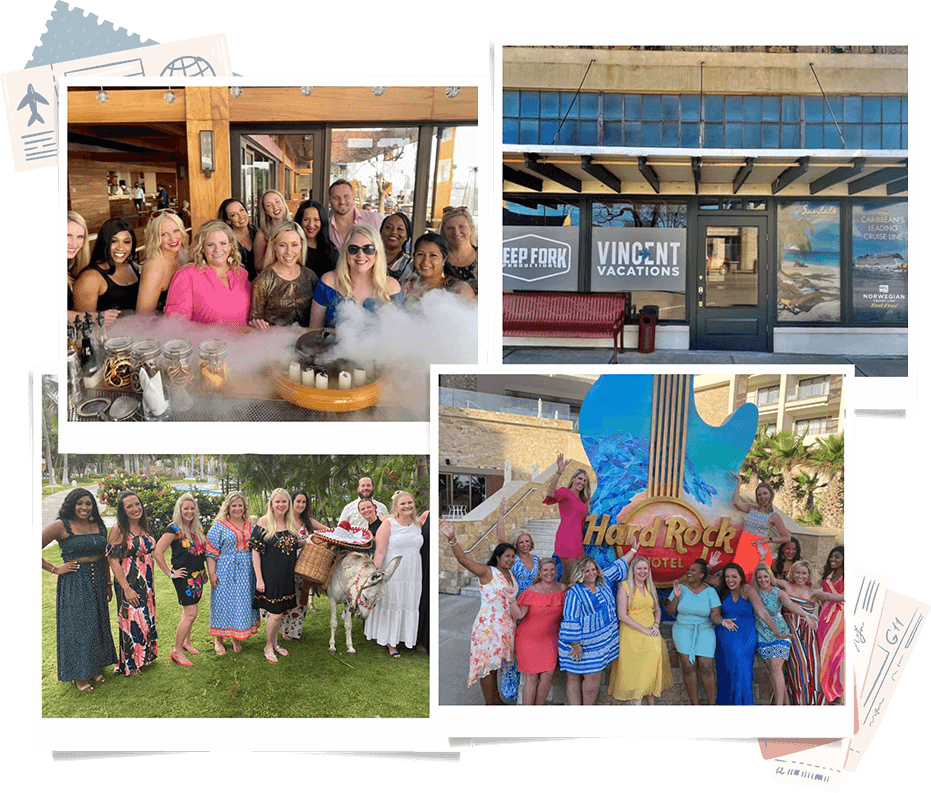We recognize that vacations are not just an investment, but often the highlights of our lives, and we take that responsibility seriously. We want to ensure we have the best travel tips for you and you have the best vacation experience. Interested in a job in travel? Click here to learn: How to Become a Travel Agent

ESPANOLA (HOOD) ISLAND- is one of the oldest of the islands. It is small and flat, with no visible volcanic crater or vent. Gardner Bay on the eastern shore offers the islands most magnificent beach. It is used by a transient colony of sea lions, and is a major nesting site for marine turtles. Around the small islets nearby, snorkelers will find fish and sometimes turtles and sharks. The trail leads from here to Punta Suarez, on the western tip of the island. Along the way you'll pass the nesting site of almost all the world's Waved Albatross, huge birds with a 6-foot wing span. Punta Suarez is one of the most outstanding wildlife areas of the archipelago, with a long list of species found along its cliffs and sand or pebble beaches. In addition to five species of nesting seabirds, Galápagos doves and sometimes Galápagos hawks can be seen. The Hood mockingbird is very curious and bold. Several types of reptiles, including the brilliantly colored marine iguana and the oversized lava lizard, are unique to this island. When heavy swells are running, Punta Suarez is also the site of a spectacular blowhole, with thundering spray shooting 30 yards into the air.
FLOREANA ISLAND- is best known for its colorful history of buccaneers, pirates, whalers, convicts, and colonists. In 1793 the Post Office barrel was established by British whalers to send letters to and from England. This tradition has continued over the years, and even today visitors may drop off and pick up letters, without stamps, to be carried to far destinations. Punta Cormorant offers two highly contrasting beaches. The landing beach is of volcanic origin and is composed of olivine crystals, giving it a greenish tinge. At the end of the short trail is a carbonate beach of extremely fine white sand. Formed by the erosion of coral skeletons, it is a nesting site for green sea turtles. Between these two beaches is a salt lagoon frequented by flamingos, pintails, stilts, and other wading birds. An old eroded volcanic cone called Devil's Crown is a popular roosting site for seabirds such as boobies, pelicans, and frigates. Red-billed tropicbirds nest in rocky crevices. The center of the crown is an outstanding snorkeling spot full of sea lions and colorful fish.
SAN CRISTOBAL ISLAND- is geologically one of the oldest, reflected by its eroded volcanic peaks in the north and densely vegetated slopes in the south. The town of Puerto Baquerizo Moreno is the capital of Galápagos Province. A bus ride through highland farms brings you to El Junco, the only freshwater lake in Galápagos. Cruise to spectacular Kicker Rock, or Leon Dormido, the jagged remains of an old tuff cone whose flanks are covered with seabirds.
SANTA FE (BARRINGTON) ISLAND- is one of the most picturesque anchorages within the archipelago. Its beauty is best appreciated from the trail which climbs the fault cliff overlooking the southern half of the bay. This plateau is also the best place to find the large land iguanas that are endemic to this island. Often they can be seen beneath the imposing Opuntia cacti that are also particular to Santa Fe. The two beaches are sleeping grounds for sea lions, and snorkeling near the small island by the entrance of the bay can also be rewarding.
SANTA CRUZ ISLAND- supports one of the largest human populations of the five inhabited islands. Some 4,000 residents are distributed between the cattle-farming communities in the lush highlands and the coastal town of Puerto Ayora. Here you can visit the Charles Darwin Research Station to see the huge land tortoises, or galápagos, which once flourished in the islands. The populations were decimated in the early 1800s by the whaling ships that stopped in the islands to fill their holds with fresh meat. A bus ride into the highlands takes you to Los Gemelos, two deep pit craters situated in the Scalesia forest with lots of interesting bird life, or for a trek through the giant lava tubes, or to the Tortoise Reserve to search for giant tortoises in their natural surroundings. On the north shore of the island, accessible only by sea, is an extensive mangrove lagoon called Black Turtle Beach. Here in the peacefulness of the mangroves turtles break the surface of the still waters, while fish, rays, and small sharks cruise below.
SOUTH PLAZA ISLAND- is one of the smallest islands to be visited. A large colony of sea lions, numbering about 1,000 bulls, cows and pups, occupies the smooth rocks here. The small cactus forest is populated by land iguanas, which can be seen sunning themselves or feeding on Opuntia pads and fruits. Along the cliff edge nesting swallow-tailed gulls are the predominant seabirds, along with tropicbirds and shearwaters. During the rainy season the dormant ground cover undergoes a drastic change. The red Sesuvium turns bright green and the leafless evening-blooming Portulaca bursts into large yellow flowers relished by the iguanas.
SEYMOUR ISLAND- is an uplifted (as opposed to volcanic) island and so is generally flat and strewn with boulders. There are good nesting sites here for a large population of magnificent frigate birds. Blue-footed boobies perform their courtship dance in the more open area, and swallow-tailed gulls perch on the cliff edges. Despite the tremendous surf that can pound the outer shore, sea lions haul out onto the beach and can be found together with marine iguanas.
JAMES (SANTIAGO) ISLAND- has several sites to visit in the region of James Bay at the western end. Puerto Egas with its black sand beaches was the site of small salt mining industry in the 1960s. A hike inland to the salt crater is an excellent opportunity to sight land birds such as finches, doves, and hawks. A walk down the rugged shoreline, especially at low tide, will turn up many marine species. Iguanas bask on the rocks and sea lions laze in the tide pools. At the end of the trail there is a series of grottoes or sea caves where fur seals and night herons are found resting on shady ledges. Just north of James Bay is Buccaneer Cove, a particularly scenic area of steep cliffs and dark beaches. A large population of feral goats now frequents this part of the island. Part of the point has been fenced off to protect the native vegetation from their destructive foraging. On the eastern coast of James Island is Sullivan Bay, a large area of fresh pahoehoe (ropey) lava flows dating from an eruption in 1897. A walk over this glazed black rock gives the impression of the still-molten lava, as every ripple, swirl, and bubble in its surface has been preserved. Only the occasional pioneering Mollugo plant gives a clue of the time needed for species to colonise such an expanse.
BARTOLOME ISLAND- is a small island off of James that offers beautiful white sand beaches fringed by luxuriant green mangroves. The eastern end of the island has many volcanic cones and lava tubes. Climb to the summit of the island for one of the most breathtaking views in the islands. The tall, leaning spike known as Pinnacle Rock is the eroded remains of an old tuff cone. At its foot is a beach for swimmers and snorkelers, and a tiny colony of Galápagos penguins.
RABIDA (JERVIS) ISLAND- has a different look, with its reddish beach, cliffs, and steep slopes of volcanic cinders. A noisy colony of sea lions lives on the beach, and a short trail inland is a good place to observe land birds such as finches, doves, yellow warblers, and mockingbirds. Hidden behind a narrow strip of green salt bush is a briny lagoon where flamingos may be found, sometimes even nesting. Snorkeling along the rocks at the east end of the beach may reveal many of the reef fish common to these waters, and the ever-present sea lions.
(GENOVESA) ISLAND- is a low volcano barely breaking the surface of the ocean. Ships sail directly into its large breached caldera to anchor at the foot of the steep crater walls. It attracts vast numbers of pelagic seabirds who come here to nest. Great frigate birds, red-footed boobies, swallow-tailed gulls and storm petrels all breed here by the thousands. A trail leads from a coral beach past tidal lagoons where lava gulls and yellow-crowned night herons are seen, then along the low shrubs populated by frigates and boobies, and eventually to a cliff edge where seabirds soar. A second trail leads to an open area for masked boobies, more frigates, and red-foots. At the end of the trail thousands of band-rumped storm petrels flutter at the cliff's edge, where they nest in crevices. Short-eared owls can sometimes be seen here, hunting the storm petrels during daylight hours.
FERNANDINA and ISABELA ISLANDS- lie on the western edge of the archipelago. They are generally visited on a longer itinerary. Fernandina is the youngest and most active volcano in the Galápagos, with eruptions taking place every few years. It is also one of the most pristine of the islands, with none of mans introduced species to date. The flat lava of Punta Espinosa gives a feel for this stark and barren landscape. Flightless cormorants build their nests on the point, and sea lions sprawl on the beach or play in the tidepools. Isabela is the largest island, made up of six volcanoes joined by extensive lava flows. There are various sites to visit around the island. A two-day trek up Alcedo Volcano will lead you to some of the last of the wild tortoises found in the islands.
Vincent Vacations - Authorized Galapagos Islands Points Of Interest Vacation Planner
Questions? Call us at
1 (888) 976-0061
For Groups of 10
or more rooms, or 8 or more Cabins, please use of Group Form
Click Here for our Group Department
From our storefronts to your destination, we are your dedicated, debt-free, and experienced travel partner.
We are a proud USA-based, 100% female-owned business. Operating completely debt-free, we offer you the stability and peace of mind you deserve when booking your dream vacation.
As a Top 20 Agency with the elite Signature Travel Network, we unlock exclusive perks, upgrades, and amenities for you that you can't find anywhere else.
Serving clients since 2013 with leadership selling travel since 2002. Our team of professionals brings decades of real-world travel experience to your itinerary.
While we have physical storefront locations you can visit, we are fully equipped to book travel for clients residing in every state across the USA.
We are a company that can be trusted. We advocate for you from the moment you book until you return home, ensuring a seamless experience.
Click on a location below to learn more. We recognize that vacations are not just an investment, but often the highlights of our lives, and we take that responsibility seriously. We want to ensure you have the best experience.

All of these are signs that you are a great fit to become an independent travel agent, and turn your love of travel from passion into profit!
Learn MoreOur motto at Vincent Vacations is, we go so you know! We want to ensure you have the BEST experience, whether it's a river cruise, or a corporate group incentive trip, we want to ensure your vacation is a success.
We serve customers all across the USA
Debt free and in business since 2013. Vincent Vacations has agents in Dallas, Kansas City, Houston, Shreveport, Little Rock, Roswell, Oklahoma City and more locations.

Travel agents can help save time and stress by doing the research and handling all your bookings for you. An experience travel agent is best at finding great deals and packages, as well as providing you with helpful information and tips. They can also help you plan special activities and experiences that you may not have thought of on your own. All in all, using a travel agent can be a great way to make sure you get the most out of your trip.
In travel since 2002, and in business since 2013, our travel team serves clients all over the US! Planning a vacation away from home takes a great team. We have taken the time to build a team of dedicated, smart, hard-working personnel who are each committed to excellence and service. We work side-by-side, creating and ensuring INCREDIBLE vacation experiences for you and your group. Our store front in-office team, and our travel consultant independent contractors, work all around the US.


In business since 2013, we are your #1 source for travel!
Free Vacation Package Quote